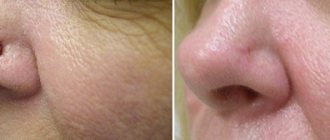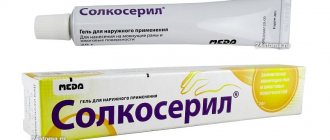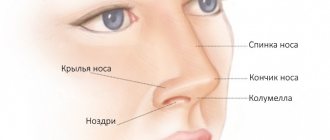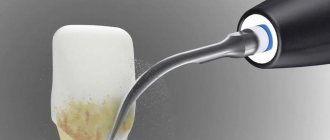Polyps are benign growths arising from the mucous membrane.
Author:
- Galkin Alexey Vladimirovich
ENT pathology expert
3.30 (Votes: 10)
Polyps are benign growths of the mucous membrane. Nasal polyps are the result of long-term inflammation in the nose or paranasal sinuses due to prolonged infection, allergens, and certain immune disorders.
Polyps of the nasal cavity and sinuses can appear in both adults and children, but they are more often observed in adults. Drug therapy helps polyps regress in size or slow their growth, but sometimes surgery is performed to relieve the symptoms of the disease. Despite successful treatment, polyps tend to re-grow.
Symptoms of the disease
Often small polyps do not cause discomfort to patients. But, large or multiple, they can block the nasal passages, leading to breathing problems, decreased sense of smell, and recurring respiratory infections.
Most common symptoms:
- chronic runny nose;
- persistent deterioration in breathing through the nose;
- decreased or absent sense of smell;
- violation of taste sensitivity;
- facial pain, pain in other parts of the head;
- a feeling of heaviness, discomfort in the eyes, facial walls of the sinuses, head;
- snore.
Causes
Scientists do not fully understand the reasons for the appearance and growth of polyps. It is not entirely clear why ongoing inflammation triggers the development of polyposis in some people and not in others.
There is some evidence that people who develop polyps have a different immune response and distinctive mucosal chemical markers.
Conditions often associated with polyposis:
- bronchial asthma is accompanied by prolonged inflammation of all airways;
- aspirin sensitivity, intolerance to certain non-steroidal anti-inflammatory drugs causes the development of an inflammatory reaction in the mucous membrane of the respiratory tract in response to medication;
- allergic fungal sinusitis, sensitization of the nasal mucosa and paranasal sinuses to microscopic fungi and their spores;
- cystic fibrosis (cystic fibrosis), a genetic disease that leads to the formation of a very viscous secretion on the mucous membrane of the upper and lower respiratory tract;
- eosinophilic granulomatosis (Charge-Strauss), a rare pathology accompanied by inflammation of blood vessels.
Side effects of the medicine
- Long-term therapy with this drug can disrupt metabolic processes in the patient's body. Therefore, with long-term use of Diprospan, the patient may notice the appearance of edema due to water retention in the body. Weight gain may also occur.
- On the part of the heart, an increase in blood pressure may be observed. If the medication is taken incorrectly, there is a risk of heart failure.
- Muscles lose their strength and mass, bones become more fragile, and there is a risk of osteoporosis.
- From the digestive system, severe flatulence is observed, and pancreatitis may develop. The walls of the stomach and intestines are affected by ulcers and erosions.
- In the presence of increased intracranial pressure, headaches and dizziness, and decreased vision may be noted. The patient may also suffer from insomnia, constant fatigue, and irritability. In severe cases, depression may develop.
- Intraocular pressure increases, vision sharpness decreases. Possible development of exophthalmos. In rare cases, the patient may lose vision completely.
- The patient’s individual reaction to the medicine can manifest itself in the form of allergies, from hyperemia and urticaria to anaphylactic shock.
- Many patients, after introducing the drug into the body, note a feeling of a sharp rush of blood to the face.
Diprospan has serious side effects
Complications
Nasal polyps can lead to complications because they interfere with the free passage of air and the drainage of mucous secretions from the sinuses.
Possible complications with nasal polyposis:
- Obstructive sleep apnea. In this condition, prolonged pauses in breathing occur during sleep, which increases the risk of cardiovascular disease and sudden cardiac death.
- Progression of bronchial asthma. Polyposis can aggravate the course of bronchial asthma.
- Sinus infection or infectious complications of chronic sinusitis. Nasal polyps increase the frequency of exacerbations of sinusitis and can lead to serious complications (for example, meningitis, orbital phlegmon, sepsis).
Price of the drug and analogues
One package of Diprospan contains from one to five ampoules of the drug. The price of the drug may vary depending on the country of manufacture. On average, the cost of one Diprospan ampoule of one milliliter can range from eighty to five hundred rubles. The price of a drug produced in Russia is noticeably lower than that of foreign manufacturers. At the same time, the place of production of the drug does not affect its quality in any way.
Analogues of the drug are “Flosteron”, “Celeston”, “Soderm”, “Depos”. We will consider the latter below.
"Depos"
Diagnosis of the disease
Your doctor can determine the condition based on your answers to questions about your symptoms, a physical examination, and rhinoscopy (a visual inspection of the nasal cavity using a light and a nasal speculum). But additional examination may be required to determine treatment tactics.
Additional diagnostic tests for polyposis:
- Endoscopic examination. Using an endoscope, the doctor can conduct a thorough examination of the nasal cavity.
- X-ray tomography. Images obtained by X-ray computed tomography (CT) provide information about the extent of polyposis involvement in the nasal cavity or sinuses. These tests can also help the doctor detect the presence of other abnormalities, such as a deformed nasal septum or enlarged nasal turbinates. Based on RCT images, the doctor may suspect a tumor growth other than polyposis (malignant or benign).
- Allergy detection. The doctor may prescribe an additional test to identify allergies: rhinocytogram, blood test for IgE, eosinophilic cationic protein, scarification tests. This is necessary in order to identify the presence of allergic pathology, which contributes to the development of polyposis.
- Test for cystic fibrosis (cystic fibrosis). A child diagnosed with chronic polypous sinusitis should be evaluated for cystic fibrosis. This is a hereditary disease that disrupts the secretion of glands, which leads to chronic inflammation of the respiratory tract and the development of polyposis.
Indications
Before prescribing glucocorticosteroids to a patient, the doctor must fully study his medical history, symptoms, and pathologies. This is necessary because in many cases this group of drugs can be prescribed in addition to existing therapy, since treatment with glucocorticosteroids alone may be ineffective.
"Diprospan" refers to glucocorticosteroids
Diseases for which glucocorticosteroids are prescribed:
- osteochondrosis of the spine, regardless of its location;
- rheumatoid arthritis;
- inflammatory processes of soft tissues and ligaments.
There are also a number of diseases for which glucocorticosteroids are used as additional therapy, including:
- allergies;
- skin lesions;
- renal failure;
- connective tissue damage.
“Diprospan” is especially effective for pathologies of the locomotor system, including osteochondrosis
Treatment of nasal polyposis
Treatment of chronic inflammation of the sinuses (with or without polyps) is a difficult task that requires complex treatment.
A team of doctors (therapist, allergist-immunologist, otolaryngologist) must participate in the treatment of the disease in order to determine an effective treatment regimen.
The goal of treatment for nasal polyposis is to reduce the size of the polyps or eliminate them. The first step begins with drug therapy. If the effectiveness of drug therapy is low, surgical treatment is resorted to. It does not provide complete recovery, but significantly improves the course of the disease. Therefore, it is necessary to continue conservative treatment in the postoperative period.
Use of medications for nasal polyposis
Treatment begins with drug therapy, which helps to reduce or disappear even large polyps.
Drug treatment usually includes:
- Nasal corticosteroids
Nasal corticosteroids have a predominantly local anti-inflammatory effect. They are used in the form of nasal sprays (with mometasone, beclomethasone) and help reduce nasal polyps.
- Systemic corticosteroids
If the administration of nasal medications is not effective, then systemic corticosteroids (dexamethasone, prednisolone, etc.) are prescribed orally or by injection. Because corticosteroids taken by mouth or by injection carry a risk of serious side effects, these drugs are not prescribed for long periods.
- Other medicines
The doctor may also prescribe other medications that affect inflammation of the mucous membrane. They may include various drugs for the treatment of allergic pathology (leukotriene receptor blockers, antihistamines, cromoglycates), antibacterial drugs for the treatment of prolonged or recurring infections.
Polyp surgery
If drug treatment does not shrink or eliminate polyps, endoscopic surgery may be required to remove them and correct sinus problems.
In the endoscopic technique, the surgeon uses a special optical tube that magnifies and displays an image of the operated area on a screen. Under visual control, the surgeon, using specialized micro-instruments, removes polyps and other obstructions from the nasal cavity and paranasal sinuses that interfere with the outflow of fluid from the sinuses.
The surgeon may also enlarge the openings connecting the sinuses to the nasal cavity.
After surgery, it is recommended to use a corticosteroid nasal spray, as well as regular rinsing with prepared saline solutions, to help prevent recurrence of nasal polyposis.
Why do scars appear?
Essentially, scars are the consequences of healing damage to the skin. After receiving a wound, the body starts recovery processes, as well as the process of producing collagen fibers. If there are too many of them, fibrous tissue will form, which is what the scars are made of. As a rule, scars differ from the surrounding skin in shade - the scar has a lighter color.
You should also distinguish an atrophic scar from a keloid one. Atrophic always forms within the limits of skin damage. Keloids also form outside the boundaries of the wound.
It is curious that scars differ from the skin not only in shade. For example, hair follicles and sweat glands are not restored in them. Therefore, after the wound heals, hair does not grow on it and sweat is not produced. In addition, the skin of scars is more susceptible to ultraviolet radiation.
Main factors influencing the appearance of scars
In general, the appearance of small scars and scars is a normal reaction of the body to skin damage. However, some experts identify a number of factors that can affect the activity of collagen production and the formation of fibrous tissue:
- Hereditary predisposition.
- Puberty.
- Pregnancy.
- Location of skin damage.
Prevention
You can reduce your chances of polyps appearing or returning after treatment by following these strategies:
- Monitor allergy symptoms. Follow your doctor's recommendations to monitor the course of your allergic disease. If symptoms do not improve, consult your doctor about changing your treatment.
- Avoid irritants to the nasal mucosa. Avoid contact with substances that can cause inflammation or irritation of the mucous membranes (smoke, a suspension of small particles, caustic chemicals, allergens, dust, animal hair).
- Maintain good hygiene. Wash your hands thoroughly and regularly. This is one of the best ways to prevent infections that can cause inflammation of the mucous membranes of the nasal cavity and sinuses.
- Control the humidity in your home. When humidity levels are low, use humidifiers. This will moisturize the airways and improve self-cleaning of the sinuses and nasal cavity.
- Use nasal cleansers. Use a nasal douche (aerosol) with isotonic sodium chloride solution to clean the cavity. This will reduce the concentration of irritating agents on the nasal mucosa (allergens, dust, germs) and reduce inflammation. If you prepare your own saline solution, use distilled or boiled water.
Storage of the drug
Glucocorticosteroids do not have strict storage rules. These medicines can be stored either in the refrigerator or at room temperature. It is necessary to ensure that the drug does not overheat. The storage location of the drug should not exceed twenty-five degrees. This medicine must also be protected from freezing.
Glucocorticosteroids are suitable for use within three years from the date of manufacture. It must be remembered that these instructions for the drug "Diprospan" are provided for informational purposes only. In order to find out more detailed information about this drug, you need to contact the manufacturer of this drug. Independent use of Diprospan is strictly prohibited. The drug is sold in pharmacies only with a prescription.
"Diprospan" is available only with a prescription









